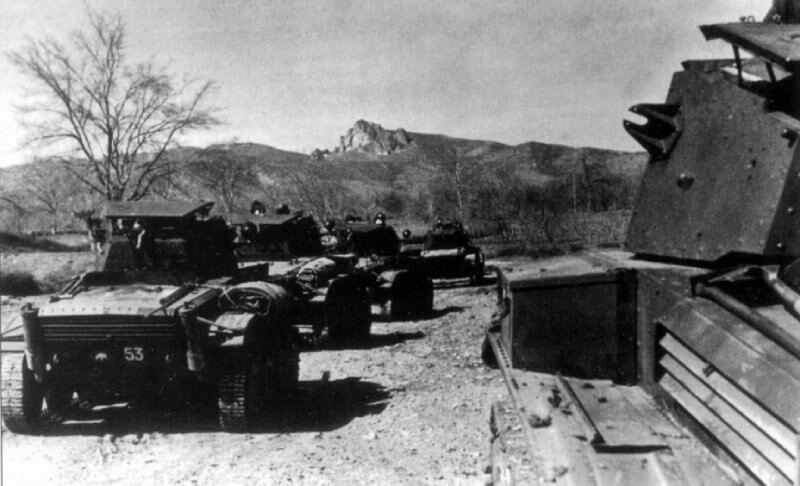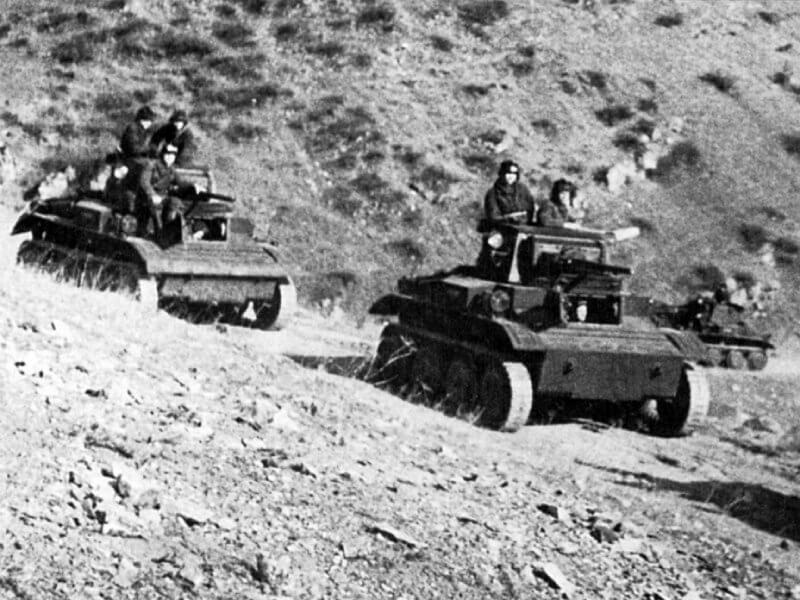| Page Created |
| October 28th, 2024 |
| Last Updated |
| October 28th, 2024 |
| Country |
 |
| Related Pages |
| British Vehicles |
| Crew |
| 3 |
| Length |
| 3,96 metres |
| Wide |
| 2.31 metres |
| Height |
| 2.12 metres |
| Weight |
| 7,600 kilograms |
| Propulsion |
| 165 horsepower, Meadows MAT H12 Petrol Engine |
| Armour |
| 14 millimetres maximum |
| Armament |
| 40 millimetres QF 2-pounder main gun, paired with a 7.92 millimetres Besa machine gun |
| History |
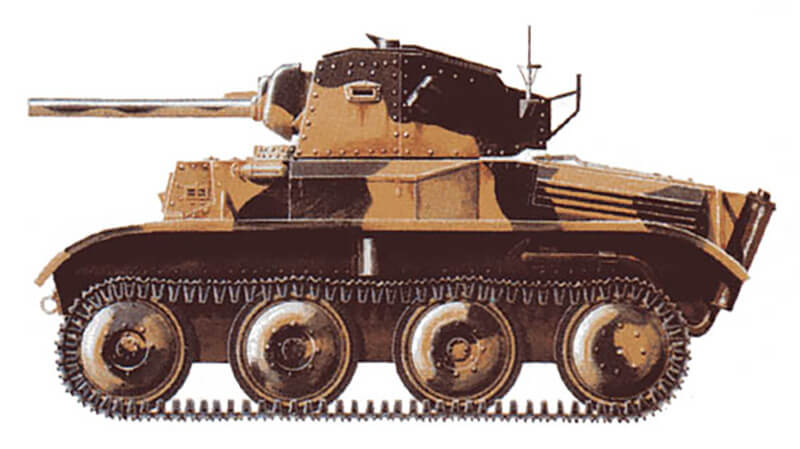
The development of what eventually becomes the Tetrarch begins as a private initiative by the Vickers-Armstrong company, aimed at selling to the British Army or foreign militaries. The company has been working on a line of light tanks, aiming to carry forward the successful elements of earlier designs for a military market that still demands light armoured combat vehicles.
It is intended to be the latest in a series of light tanks produced by the company, designed to address the issue of insufficient armament found in earlier models that were equipped only with machine guns. To address this, Vickers-Armstrong fits the Mk VII with a 40 mm QF 2-pounder main gun, paired with a 7.92 mm Besa machine gun, both mounted in a two-man turret. The tank has a maximum armour thickness of 14 mm. The prototype weighs approximately 7,600 kilograms and is powered by a 165 horsepower Meadows engine. The suspension system consists of eight road wheels, four on each side, with no separate driver or idler wheels, enabling a top speed of 64 km/h.
The Mk VII incorporates an unconventional steering method, adapted from earlier Vickers models. The front wheels are steerable, allowing for gentle turns by bending the tracks, while sharper turns require braking one track, a more conventional tank steering approach. This dual steering system is designed to reduce mechanical strain and minimise power wastage. The suspension system is also innovative, relying on struts with air pockets for springing and oil cushions for damping, with each wheel independently sprung.
In 1937, a prototype is produced by the Metropolitan-Cammell Carriage and Wagon Company, a subsidiary of Vickers-Armstrong, and testing follows in 1938. At this stage, the vehicle is known as the “PR Tank” and also goes by the name “Purdah”.
The War Office examines the design and conducts a series of trials in May and June 1938, evaluating it as a potential ‘light cruiser’ tank, as its predecessor, the Mark VI, already meets the current light tank requirements. However, the War Office concludes that the Mk VII is unsuitable as a light cruiser because the Nuffield A13 design offers superior speed and obstacle-crossing capabilities. Despite this assessment, the decision is made to produce some Mk VII Light Tanks at the end of the light tank programme. In November 1938, the War Office assigns the Mk VII the official General Staff specification number A17 and approves limited production after requesting several minor modifications, including the addition of an external fuel tank to extend the tank’s operational range.
The number of Mk VII Light Tank units to be produced fluctuates as the War Office changes its requirements. In July 1938, the War Office requests the production of 70 tanks, but after a three-day conference in November, the request is increased to 120. Production is planned to begin in July 1940, but the War Office then temporarily reverts to the original order of 70, before increasing it to 100. The number eventually rises to 220 after Metropolitan Cammell Carriage & Wagon, a company partly owned by Vickers-Armstrongs that is involved in the production, indicates it has already ordered enough armour plating for that many tanks.
Production is delayed by several factors. After the Battle of France, the War Office puts the order on hold to prioritise the production of infantry and cruiser tanks, following the poor performance of British light tanks during the battle.
Nevertheless, the first Mk VII Light Tanks are delivered to the Army in November 1940. Initially, they are deployed with the 1st Armoured Division, which is being refitted after heavy losses during the Battle of France, and the newly formed 6th Armoured Division.
By this stage, both the War Office and the Army conclude that light tanks are too vulnerable and a liability in combat, and the Mk VII Light Tank is considered obsolete. Especially as the pre-war role of the light tank, reconnaissance, proves to be better suited to scout cars, which require smaller crews and have superior road capabilities. Operational use of the Tetrarch also reveals several design flaws. Its compact size limits the crew to three members, a driver in the hull and a gunner and commander in the turret. This reduced crew is insufficient for the effective operation of the tank, as the gunner or commander must also perform the role of loader for the 2-pounder gun, resulting in delays during combat. A report from January 1941 highlights that the commander, tasked with both fighting and managing the tank, finds it nearly impossible to control a troop of Tetrarchs effectively during battle. Further issues arise with the Littlejohn adaptor fitted to the 2-pounder gun, which is intended to enhance its range and penetration power. Once fitted, the adaptors cannot be removed and can only fire specially designed armour-piercing rounds, which are time-consuming to manufacture.
This could have marked the end of the Mk VII Light Tank’s active service, particularly as several units intended for deployment to the Eighth Army in the North African Campaign remain in Britain after their cooling systems are deemed unsuitable for the intense desert heat. The Tetrarch tanks remain in Britain and are initially intended for use as training vehicles before being retired. Further delays in production arise in May 1941 due to Luftwaffe bombing raids targeting the factories where the tanks are assembled. The cumulative effect of these delays results in the production of only a limited number of Mk VII tanks, with estimates suggesting between 100 and 177 units being produced. The name “Tetrarch” is officially assigned to the Mk VII on September 22nd, 1941, following orders from the War Office. The last of these tanks are built in the first quarter of 1942 and delivered by the end of the year.
| Special Service Squadron |
However, the Mk VII Light Tank’s demise is prevented by a decision from the War Office in mid-1941, the Royal Armoured Corps forms three tank squadrons for special overseas operations, named A, B, and C Special Service Squadrons. A and B Squadrons are equipped with Valentine infantry tanks and Mark VIc light tanks, while C Squadron receives twelve Tetrarchs transferred from the 2nd Armoured Brigade of the 1st Armoured Division. C Squadron is officially activated on July 31st, 1941 and is promptly ordered to prepare for overseas service alongside A and B Squadrons, with a focus on deployment to an unspecified tropical climate. The three squadrons undergo intensive training at Inverary in Scotland, practising embarkation and disembarkation from ships and landing craft, in preparation for possible amphibious operations.
In early September, elements of C Squadron, including six Tetrarchs, are deployed as part of a force sailing for Freetown in West Africa. At the time, there are concerns that Spain might join the war on Germany’s side, and the force is prepared to capture Spanish islands off the African coast if necessary. These concerns prove unfounded, and the unit returns to Britain in March 1942 to rejoin the rest of the squadron for further training.
The next assignment for C Squadron is Operation Ironclad, the invasion of Madagascar, then under Vichy French control. The aim of the operation is to occupy Madagascar quickly to prevent its ports from being used by Japanese naval forces, which are active in the Indian Ocean. The invasion force, commanded by Major General Robert G. Sturges, includes No. 5 Commando, the 29th Independent Brigade Group, and elements of the 5th Infantry Division. The core of the invasion force is the 29th Independent Brigade Group, which is reinforced by B Special Service Squadron, consisting of six Valentines from B Squadron and six Tetrarchs from C Squadron.
The invasion begins on May 5th, 1942 with amphibious landings near Diego Suarez. Although the infantry lands successfully, B Squadron faces difficulties when a Tetrarch becomes stuck in the sand, blocking further landings for several hours. Eventually, some tanks join the infantry, but they struggle to manoeuvre over the rocky terrain and are unable to breach the French defences, which consist of camouflaged trenches, pillboxes, and artillery. The French artillery proves capable of penetrating the Tetrarch’s and Valentine’s armour, resulting in several tanks being destroyed. By the time the French surrender, only one Valentine and three Tetrarchs remain functional.
Following Operation Ironclad, C Squadron remains in Madagascar until early 1943 before being shipped to India to participate in the Burma Campaign as part of the 29th Independent Brigade.
| Airborne Role |
Meanwhile, in January 1942, the War Office decides that a light tank unit will support the division, designated the Light Tank Squadron, consisting of nineteen light tanks intended to operate ahead of the division to capture and hold objectives. When selecting equipment for these airborne units, the War Office determines that gliders will be essential, capable of transporting troops as well as heavy equipment, which by 1941 includes artillery and tanks. Plans for airborne tank transport go through several revisions, but by May 1941, a 5.5-tonne tank is deemed feasible for glider deployment, though a specialised aircraft must be developed. In a conference on January 16th, 1941, it is decided that the General Aircraft Hamilcar, then under development, will be used to transport either a Mk VII Light Tank tank or two Universal Carriers. The Tetrarch is chosen largely because it is considered obsolete and readily available for use by the airborne forces.
C Special Services Squadron, which is still equipped with Tetrarchs, is selected for this role and officially transfers to the 1st Airborne Division on June 24th, 1942. The unit begins training immediately but is not attached to the division for long, as the division is deployed to the Middle East for the invasion of Sicily. Insufficient numbers of Hamilcar gliders to transport the Tetrarchs prevent C Squadron from joining them, and instead, the squadron transfers to the newly formed 6th Airborne Division in April 1943.
With increasing glider capacity especially Hamilcars, C Squadron is attached to C Squadron of the Glider Pilot Regiment. The Glider Pilot Regiment starts conducting an extensive training programme with the Mk VII Light Tanks, completing no fewer than 2,800 training flights, with only three accidents resulting in the deaths of seven pilots. The tanks used for these air-transport operations are modified specifically for glider deployment. They are fitted with extra fuel tanks and storing capacity and some have their the original 40 mm gun with a 76.2 mm howitzer. These modified tanks are designated as Tetrarch Mk. 1 ICS (Infantry Close Support). The tank squadron also continues to train in airborne operations, including reconnaissance and counter-attacks.
In December 1943, the War Office decides to expand the squadron into a regiment equipped with light tanks and reconnaissance vehicles. On April 1st, 1944, the unit becomes the 6th Airborne Armoured Reconnaissance Regiment, consisting of a Headquarters Squadron, a Light Tank Squadron, and a Reconnaissance Squadron. A Squadron, the Light Tank Squadron, receives the majority of the Tetrarchs, including models fitted with 2-pounders and others fitted with infantry support howitzers.
The regiment prepares for Operation Tonga, the British airborne landings in Normandy, which begin on June 6th, 1944. Due to insufficient transport aircraft, the entire division cannot be deployed simultaneously, and A Squadron lands later during the day. The landing is fraught with difficulties, including several Tetrarchs being lost when their gliders crash or are damaged during unloading. Despite these losses, the surviving tanks support reconnaissance efforts and engage German positions, but they are outmatched by German armour such as the Panzer IV and Sturmgeschütz III. By August 1944, most of the Tetrarchs in A Squadron are replaced with Cromwell cruiser tanks. Operation Tonga marks the final combat deployment of the Tetrarch.
In October 1944, the 6th Airborne Armoured Reconnaissance Regiment is restructured, and the remaining Tetrarchs are retired from service. They are replaced by the M22 Locust, an American airborne tank. The 6th Airborne Armoured Reconnaissance Regiment uses the M22 during Operation Varsity in March 1945, the airborne crossing of the River Rhine.
| Lend-Lease Programme Soviet Union |
On June 22nd, 1941, Germany launches Operation Barbarossa, the invasion of the Soviet Union, making the USSR now an ally of the Allied. The Lend-Lease programme, initiated in March 1941 by the United States to supply defensive materials to Great Britain and China, is subsequently extended to include the USSR.
The Soviet Union initially has limited interest in British light tanks before World War II. By April 1941, Soviet authorities are aware of several British models, but detailed information remains scarce. During negotiations in September 1941 for British tank supplies, confusion arises regarding the classification of British tanks, with the Light Tank Mk VI and Mk VII “Tetrarch” mistakenly combined into a single model.
In late September 1941, the first convoy’s plans include mention of a “Light Tank Mk VIII,” which actually refers to the Tetrarch. However, instead of these lighter tanks, twenty Matildas and Valentines are sent to the USSR, delaying the shipment of lighter vehicles. By October 1941, Soviet intelligence gathers more comprehensive information about British and American tanks, and by December, they receive detailed tank production figures. These records match modern data, showing that one hundred Tetrarch tanks are produced between late 1940 and the third quarter of 1941. A newer model, the Light Tank Mk VIII with improved armour, is also reported to be in development.
The first Tetrarch tanks are finally delivered to the USSR via the southern route, arriving in Zanjan, Iran, in December 1941. However, this shipment of twenty tanks proves to be the last due to the Tetrarch’s limitations. Part of the shipment consists of previously used tanks, including some with the insignia of the 10th Royal Hussars Regiment, indicating prior use as training vehicles. Soviet authorities also require the presence of British instructors to oversee training for the tanks.
By January 1942, the tanks are sent to Baku, though spare parts remain an issue. It is arranged for parts to be delivered via Arkhangelsk, and in the meantime, the tanks are stationed in Baku. In March, the Tetrarchs are reassigned to the 21st Independent Training Tank Regiment in Shaumian, Armenia. During this period, Mark Redkin, a photographer from TASS, takes photographs of the tanks in use, inadvertently causing a diplomatic incident when the classified images are shared publicly.
In May 1942, the tanks are reassigned again, becoming part of the newly formed 151st Tank Brigade, under Colonel V. A. Kornilov. The brigade joins the 45th Army in the North Caucasus Front and is tasked with guarding supply routes along the Iranian border. By June, the 151st Brigade fields twenty-five T-26 tanks alongside twenty Tetrarchs, with Tetrarch T.9328 later being sent to Kubinka.
By November 1942, a report summarises the Tetrarch’s significant shortcomings: inadequate cooling, fragile components, weak suspension, and poor armour. These issues limit the Tetrarch’s effectiveness in challenging conditions. In January 1943, during the Battle for the Caucasus, the 151st Tank Brigade sees its first combat, but rough terrain and communication issues hinder progress, leading to unsuccessful offensives and withdrawal by February for reorganisation.
In March 1943, the Tetrarchs are transferred to the 563rd Independent Tank Battalion. By May, fewer than ten are operational, and by September, only two Tetrarchs remain in service, effectively marking the end of their combat role in the Soviet Army. Despite serving for nearly two years, the Tetrarch proves unsuitable for prolonged or intense military operations.
Engineer Lieutenant-Colonel Kalinin’s evaluation in August 1943 finds the Tetrarch to be poorly armoured, mechanically unreliable, and generally ineffective except for escort duties or actions against minimal resistance. By January 1944, the last mention of the Tetrarchs in Soviet service is recorded, with three tanks undergoing repairs at Factory No. 66 in Tbilisi. However, with no available spare parts, all three tanks are written off, ending the Tetrarch’s service in the Soviet military.
| Post War |
In January 1946, the War Office confirms that the Tetrarch design is obsolete, and any future light tanks for airborne use will be of new design. However, a small number of Tetrarchs remain in service with the 3rd The King’s Own Hussars until 1949, where they are used in training exercises with Hamilcar gliders stationed at Royal Air Force Fairford. Glider training is discontinued in 1950, and the Tetrarchs are subsequently withdrawn from service.
| Variations |
The Tetrarch design evolves into several variants. The first is the Light Tank Mk VIII, developed by Vickers-Armstrongs as the intended successor to the Tetrarch. Known as the Harry Hopkins, named after President Roosevelt’s chief diplomatic advisor, it is given the General Staff design number A25 by the War Office. The Mk VIII aims to improve upon the Tetrarch’s design in multiple areas. Armour thickness is increased, with the front hull and turret strengthened, and side armour also enhanced. The turret and hull are re-designed with more sloped surfaces to better deflect incoming shells.
The dimensions of the Mk VIII are slightly modified from the original Tetrarch, making it 15 centimetres longer, approximately 38 centimetres wider, and generally heavier. Due to this increased weight, the Mk VIII is no longer suitable for air transport by a Hamilcar glider. It retains the Tetrarch’s 12-cylinder engine, but the added weight reduces its top speed. The armament also remains unchanged from the Tetrarch. In April 1941, the War Office authorises the construction of three prototypes. Although initially deemed successful, further testing reveals persistent developmental issues, leading to production delays. In December 1942, a report notes these delays, and the problems persist into 1943. The War Office eventually decides not to adopt the Mk VIII for active service. Production concludes in 1945, with approximately 100 units completed.
Another variant of the Tetrarch is the Tetrarch Duplex Drive. The Duplex Drive system, invented by Nicholas Straussler, allows the tank to float and participate in amphibious operations. The system involves erecting a large waterproof canvas screen around the tank, supported by inflatable tubes and steel struts, providing enough buoyancy for the tank to float. A propeller, powered by the tank’s engine, propels the vehicle through water. Upon reaching land, the screen can be collapsed using a small explosive charge. The Duplex Drive system is fitted to the Tetrarch in June 1941, as it is the lightest available tank. The Tetrarch Duplex Drive Mark I DD, equipped with the equipment Straussler Duplex Drive, is tested in Brent Reservoir that same month. The modified tank successfully undergoes tests on other lakes and reservoirs, which eventually leads to the application of the Duplex Drive system to heavier tanks, such as the Valentine. The system is later used during Operation Overlord, allowing M4 Sherman tanks to land on the invasion beaches.
| Multimedia |
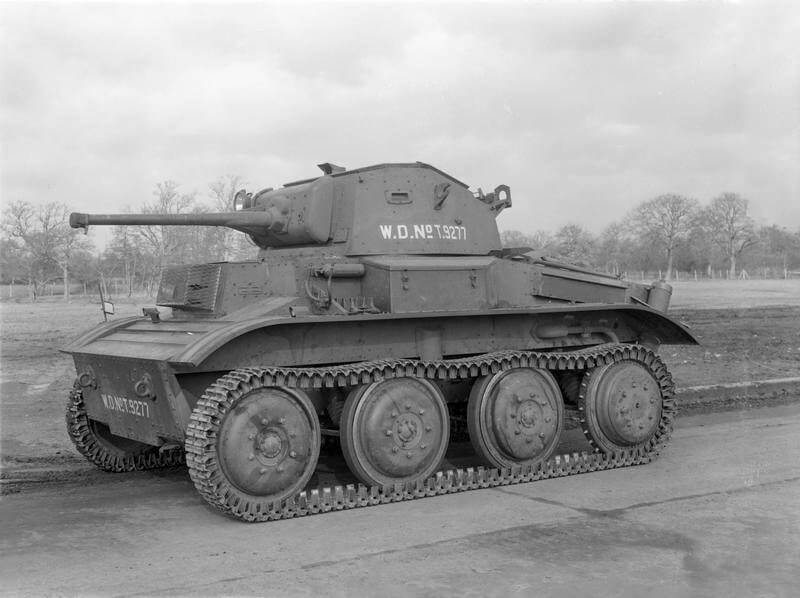
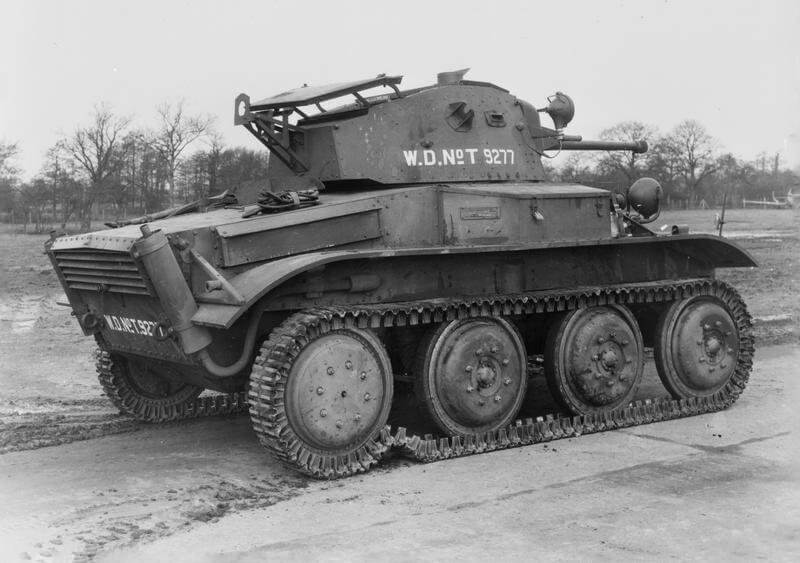

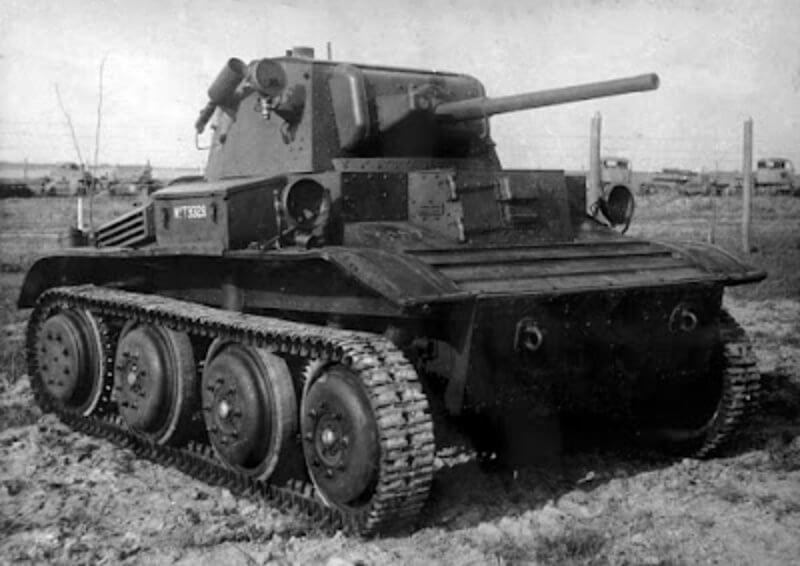


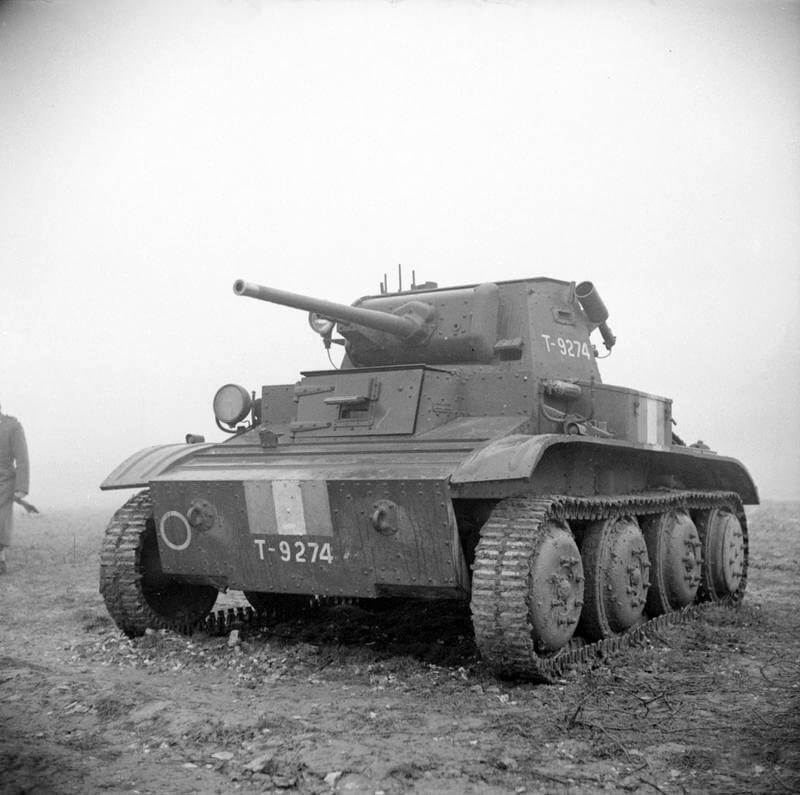
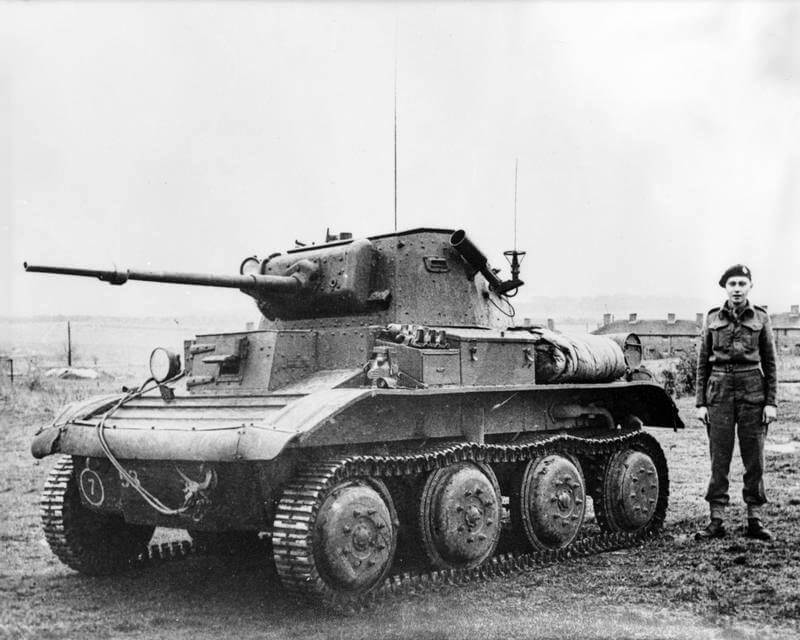
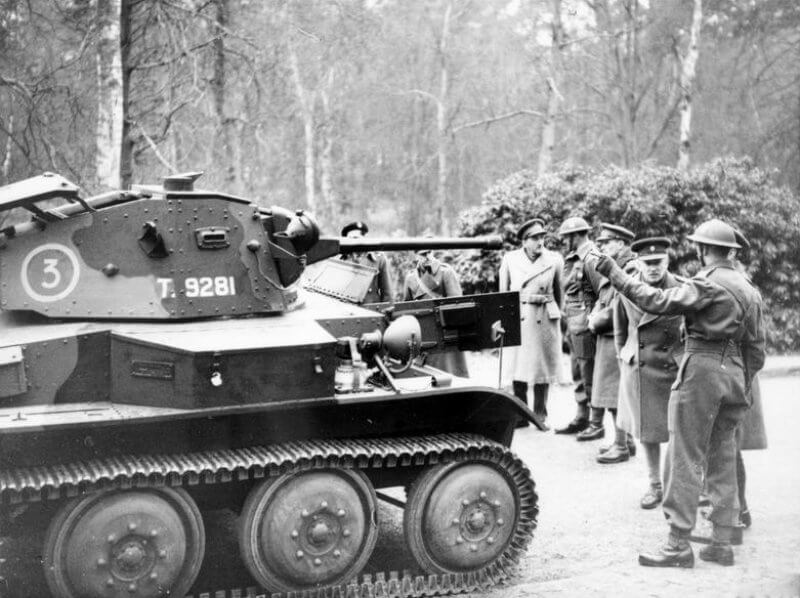



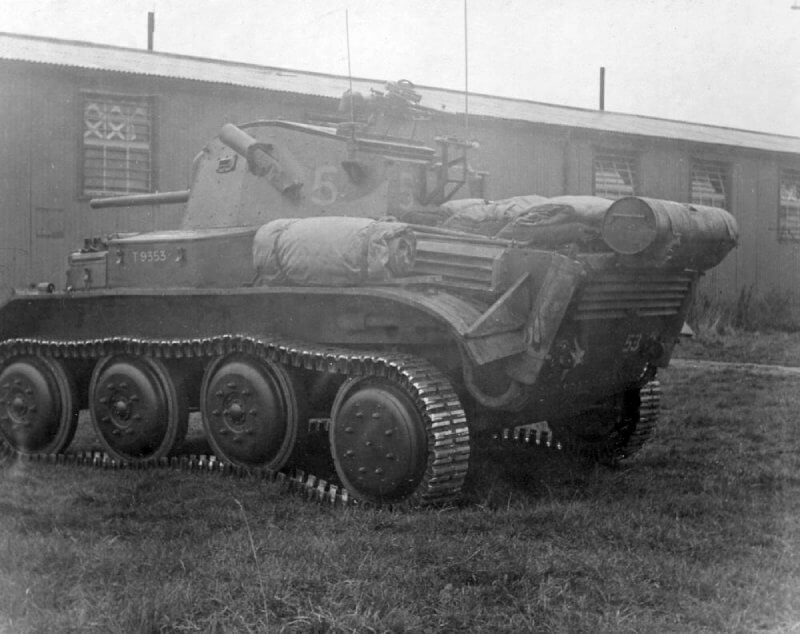
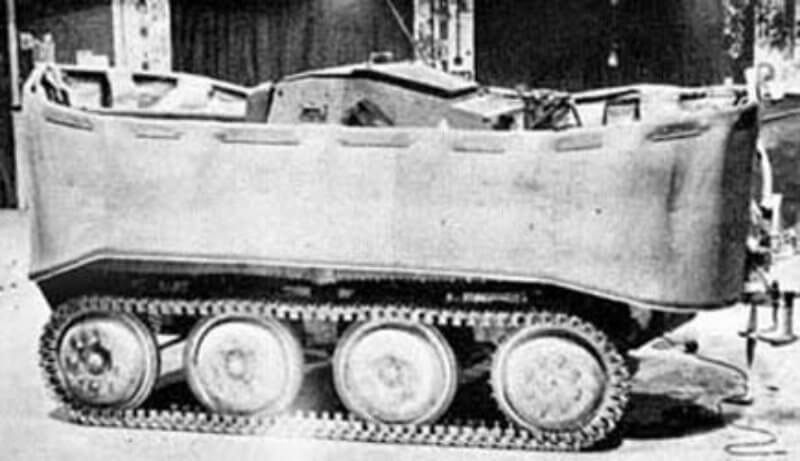
| Hamilcar loading a Tetrarch |
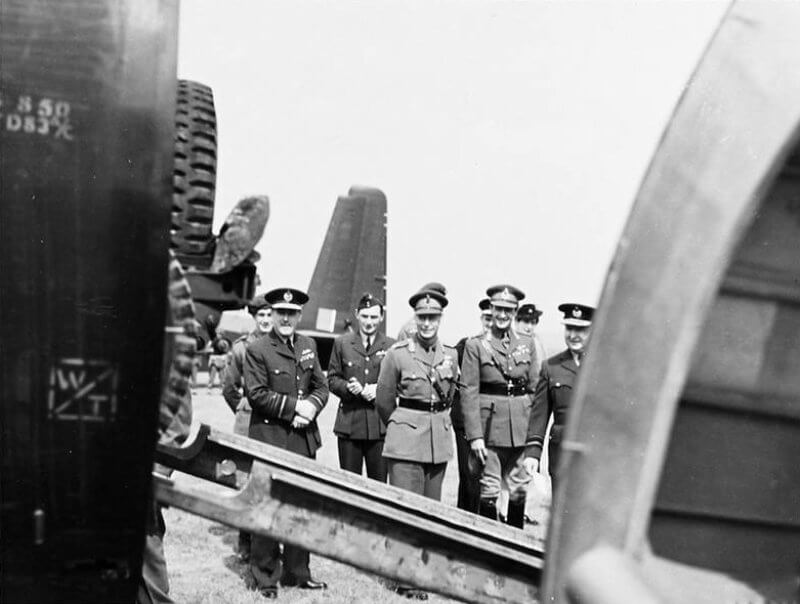
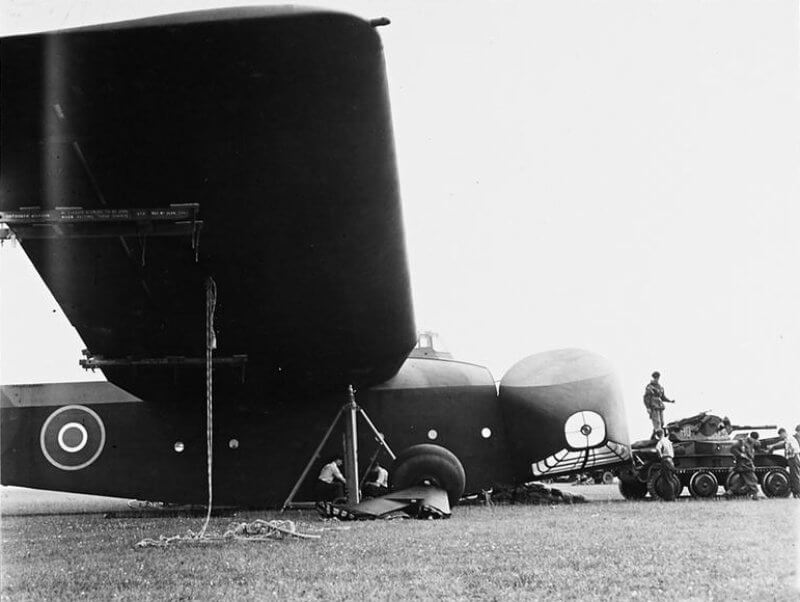
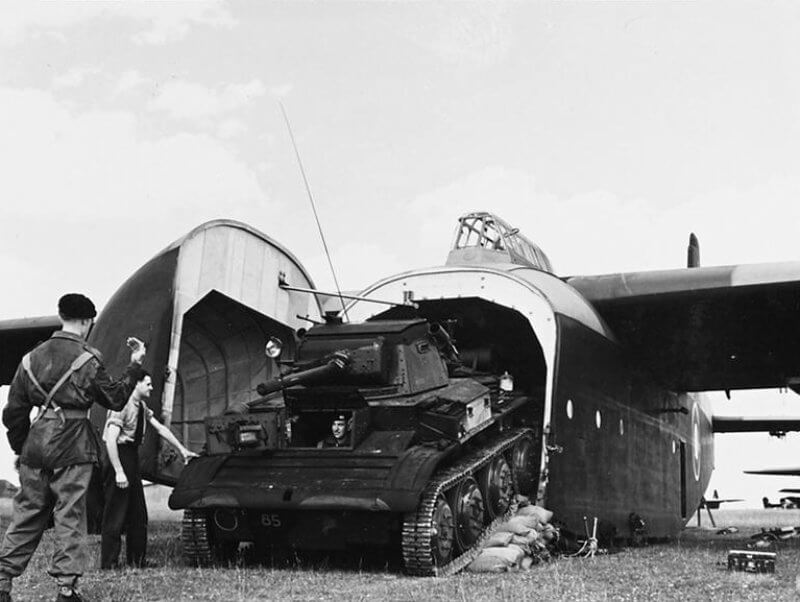
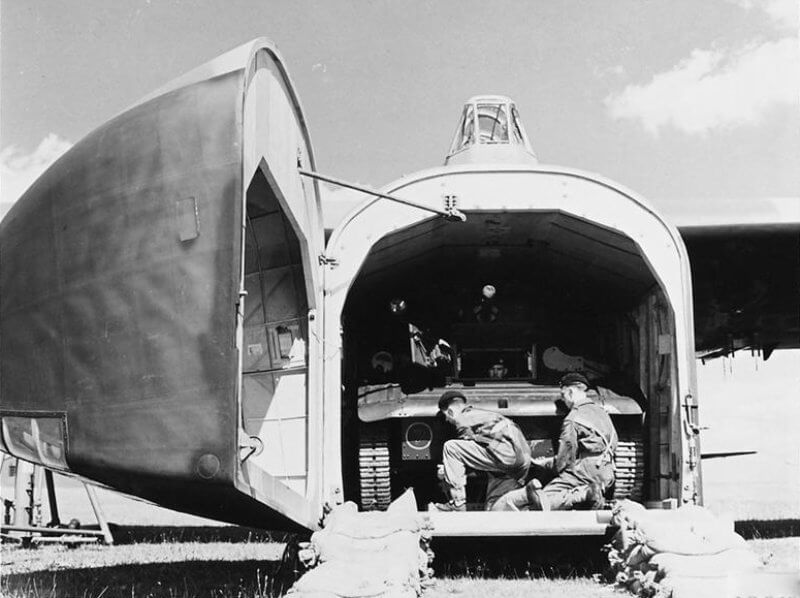
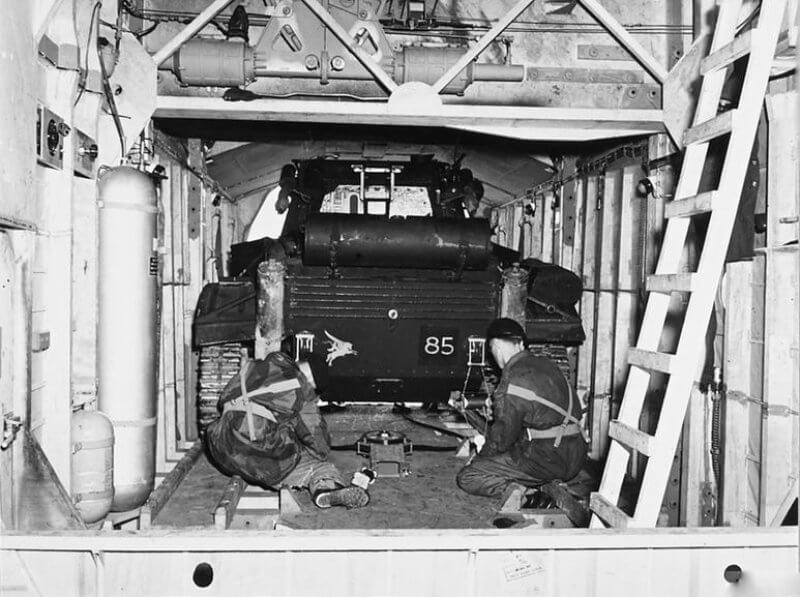
| Operational Use |
